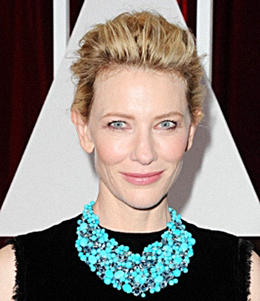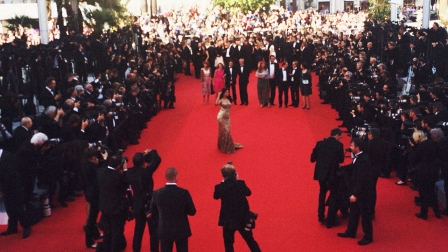The Big Business Of Red Carpet Bling
Actress Cate Blanchett is celebrated for her unconventional, avant-garde awards-show fashion. But at the 2015 Oscars, it was her jewelry that stole the red carpet show: She paired a long, simple black Maison Margiela gown with a Tiffany & Co. turquoise and diamond necklace. It dominated fashion headlines and soon thereafter, inspired knock-offs and Etsy reimaginings. Us Weekly promoted a $75 Blanchett-inspired jewelry giveaway.

“We didn’t plan on it,” says Blanchett’s stylist, Elizabeth Stewart. “But it worked.”
When it comes to Hollywood baubles, the motto is generally, “Go big or go home.” To compete with couture gowns and Cinderella moments, top jewelers such as Bulgari, Chopard, and Forevermark go all out to secure their celebrity endorsements. It’s a lengthy, complicated loaning process, and a chance at worldwide brand recognition.
Sometimes celebrities or stylists are paid to wear the accessories, with compensation potentially hovering in the hundreds of thousands. Sometimes the jeweler will “thank” the star by “gifting” them jewelry. Sometimes the generous one-night loan is the sum total. It varies, and those involved are historically mum on the transaction specifics.
A Pricey Process
It starts with the stylist, the unsung maestro of all Hollywood red carpets. Stewart, whose clients also include Julia Roberts, Sandra Bullock, and January Jones, starts with the dress, then moves her way to accessories. “Often, the jewelry comes last,” she says, but stresses that it is “very important” to create a full look.
The next step is the insurance companies. Jewelers might provide the insurance, but most commonly, stars already have existing relationships with insurance agents and a policy that seamlessly weaves in additional loans.

“Individuals of some level of wealth normally have some kind of jewelry coverage in place,” explains Janece White, vice president, North American underwriting and jewelry specialist of Chubb Personal Risk Services, which counts high-profile celebrities as clients. Even if it’s just for what she calls “the basics”—their engagement rings or earrings—deep-pocketed celebrities often get covered.
If the client is a “good customer” who has had a relationship with the agent for years, Chubb will offer the additional coverage, but they need the specifics of the loaned pieces and how they will be stored, transported, and secured. “It’s usually not just one piece of jewelry,” White says. “The stylist brings back a number of pieces—sometimes a couple million dollars worth.”
White and her associates are available throughout the days leading up to awards shows, waiting on frantic last-minute calls from clients who might need to insure a $5 million diamond choker. It’s a frenzy. They also act as consultants, offering recommendations on services such as security firms that can provide armored trucks and guards, which could run well over $20,000.
“Would it be acceptable to throw [the jewelry] in the back of a cab? No,” White says. “Would it be acceptable to have [the client] come with someone very secure to take the items back by personal car? Yes.” Most clients, says White, take good care of their loans, because “they want to borrow something again the next award season.”
With all that prep work, there is still no guarantee the star will wear a specific item. A stylist has multiple looks on hold in the dressing room hours prior to an event, and sometimes last-minute decisions occur.
“I can’t tell you how many times the backup dress becomes the dress,” said Stewart. “You really don’t know until it’s all put together.” And if the gown changes, so too will the accessories. Stewart cites a number of reasons why one or both might not make the final cut: hair, makeup, and even just one’s mood.
The Brand Name Game
For many companies, the goal is to tie themselves to the right star whose name signifies aspirational wealth and glamour.
“There’s a lot that goes on behind the scenes in terms of determining who that million-dollar actor is going to be walking down the red carpet,” says style expert Anna De Souza. “It’s not about selling that particular piece—it’s about brand recognition.” Celebrities are repeatedly asked, “Who are you wearing?” with designer names appearing in celebrity and fashion magazines for weeks thereafter.
For stars, borrowing baubles is a mark of success. And consumers understand that the bigger the star, the bigger the bauble.
“Beyond the event itself, media will cover different celebrity looks—i.e., who wore what, not to mention a huge social media audience weighing in on each celebrity look, garnering mentions for brands,” says Crosby Noricks, a fashion brand strategist and founder of PR Couture. “When a company like Tiffany’s or Bulgari does a product-placement deal with a celebrity, if they get the right star, it can certainly add a valuable spotlight to their product, image, and brand.” It can also bolster a certain campaign. Cate Blanchett’s turquoise homerun served to promote Tiffany & Co.’s Blue Book collection.
Snagging an international star is paramount. This is especially true for smaller jewelry companies trying to secure placement in bigger retailers or to enter a new market, like Dubai. Being able to approach new opportunities with the claim that “Jennifer Lopez wears our jewelry” can be the ticket in.
Labels have their own specific needs and who they want to reach. For publicly traded companies like Tiffany & Co., which boasts over 300 stores and sells high and more modestly priced collections, it makes sense for them to place their products on a wide range of stars, ranging from Oscar winners to TV actresses, at various industry events. Chopard wants to master the red carpet, so you might see their products at movie premieres, in addition to awards shows.
Anna Hu Haute Joaillerie sells colorful jewelry with whimsical, intricate imagery like flowers and butterflies. Price points range from $100,000 to $7 million. The brand was relatively unknown until Madonna wore an Anna Hu Haute Joaillerie diamond cross pendant necklace to the 2009 Met Gala. “That put Anna on the global map,” says Carineh Martin, the company’s chief marketing officer.
Today, Hu’s styles adorn A-listers such as Gwyneth Paltrow and Emily Blunt—but only at the three high-profile events: the Oscars, the Met Gala, and the Cannes Film Festival. The designer takes the rare approach of relying on a select few celebrities to foster an image of exclusivity.
“It has to be the top event, the top actress, with the top jewels, otherwise it’s just not interesting for us,” Martin says. “If that means only one or two a year, that’s all we’re interested in.”
It makes sense, considering the brand has only one store, and most sales are private custom orders. That’s precisely what a certain clientele wants—the sense that they’re wearing something rare and special. “How can you be exclusive when you have 600 stores worldwide?” Martin says.
“We are about being private jewelers to a very small echelon of clientele, so everything we do is with that in mind, including our red carpet approach,” she says. “We could dress a lot more people and have a lot more awareness, but when you’re not readily available all over the world, what’s all that awareness going to do for you? We’d rather be known by fewer people, but the type of people who respond to our jewels.”
As Seen On . . .
There are those who want exactly what the stars are wearing. Fine jewelry designer Irene Neuwirth has been contacted while celebrities were still modeling her designs on the red carpet. She sold two emerald cuffs, each at $150,000, while they were still on Julianne Moore’s wrist at the 2013 Met Gala.
Iconic moments can immediately help sell a style. Gwyneth Paltrow went down in fashion history following her 1999 Oscar win, when she clutched her gold statue in a pink Ralph Lauren gown and a 40-carat Harry Winston diamond necklace. The jewelry house immediately sold a few necklaces in the same style, reportedly at over $100,000 each. One buyer was Paltrow’s own father, who gave his daughter the jewels as a gift.
As for how this visibility affects companies’ bottom lines, that’s a complicated equation. According to Milton Pedraza, CEO of the Luxury Institute, a consulting firm serving more than 1,000 luxury and premium goods, what consumers consider the most prestigious and what consumers actually buy don’t always align. In a recent study, the Luxury Institute found that households earning over $200,000 were most familiar with the following brands, in descending order: Tiffany & Co., Cartier, Bulgari, Gucci, Chanel, Harry Winston, De Beers, Van Cleef & Arpels, Mikimoto, and David Yurman.
And here’s where they spent their money: Tiffany & Co., Cartier, Alexis Bittar, David Yurman, Gucci, Bulgari, Chanel, Boucheron, Mikimoto, and Judith Ripka. The two categories diverge, since consumers can’t always afford what they’re familiar with, but they still want designer.
Consumers with household incomes under $75,000 tend to own items from Tiffany (76%), Bulgari (32%), and David Yurman (21%).
“Millennials are very aspirational,” Pedraza says, noting their constant media intake of celebrity fashion and culture. They’re attuned to researching a product or a celebrity they want to emulate. “They are now in the know.” They might only buy a pendant necklace or bracelet, but they’re still buying.
The majority of Americans don’t have the means to even consider buying a pricey piece of jewelry that was seen on the red carpet, but there are other opportunities to partake in the luxury sector.
“The average TV viewer isn’t going to go out and purchase [the exact item], but they might pick up a pair of sunglasses, perfume, or wallet in order to align themselves with an aspirational brand worn by their favorite celebrity,” Noricks says.
Buying the jewelry isn’t necessarily the point of these celebrity endorsements. It’s to get the brand on your mind—for future purchases. They’re in this for the long haul.
As style expert Anna De Souza says, “It goes way beyond the 10-minute walk down the red carpet for these brands.”
Fast Company , Read Full Story
(12)


